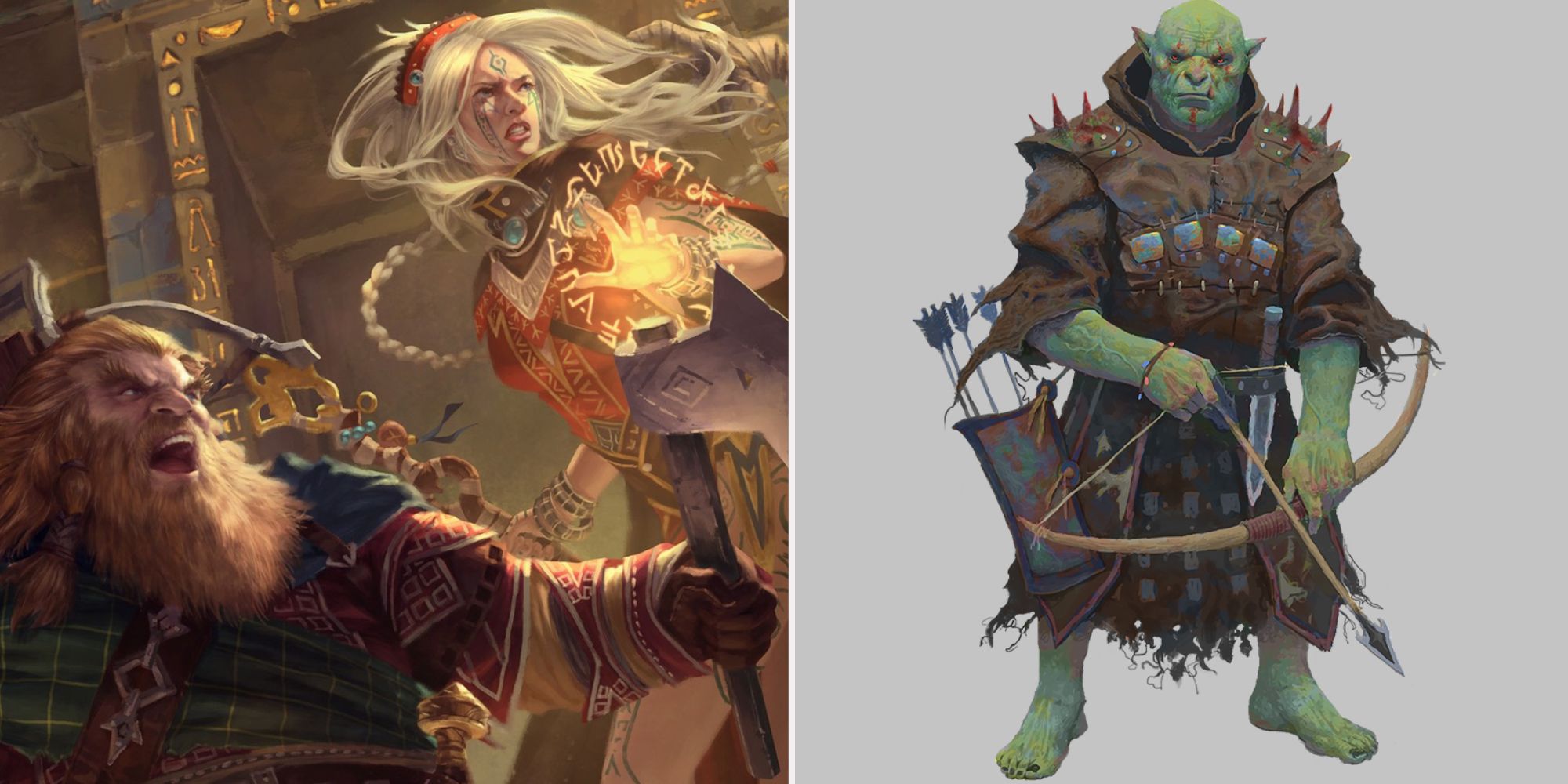
Summary
- Pathfinder Second Edition's remaster consolidates features into single books for easier reference.
- The Orc ancestry in Pathfinder Second Edition has different heritages, such as Badlands Orc and Winter Orc, each with their own unique strengths and weaknesses.
- Some Orc heritages, like Deep Orc and Rainfall Orc, are situational and may not always be useful depending on the campaign or adventure.
Pathfinder Second Edition's revamp brings together errata from the past four years of growth, consolidating features into single books while performing layout cleanup. The current Player Core book gives updates for most ancestries, but Orc appears to be relatively untouched.
Related11 Of The Best Archetypes In Pathfinder
Power up your character with these amazing archetypes.
PostsThis is a blessing and a curse for the people of strength and survivability, giving players a stable ancestry for reference but leaving it out of the loop when it comes to any new toys and ideas. With the changes to the game, however, there are possibilities for shakeups in the heritage’s strengths. Let’s explore and see just how much has changed.
7 Badlands Orc
Art via Paizo Inc.Giving your character Badlands heritage means that you want your Orc to value their elemental survival abilities above all else, especially in the hottest of places. This means your Orc can run for days thanks to the ability to Hustle for twice as long. You’re also able to survive heat better than most, so temperature effects are lowered a step in hotter climates.
Unfortunately, these effects are all exploration related, which is notoriously skipped to allow for more combat and role-playing. This means you won't feel your heritage's power unless you find yourself in some very specific adventures.
Pathfinder Definitions:
- Hustle: Gives you the ability to move at twice your travel speed during exploration. Lasts as long as your Constitution Modifier x 10, minimum 10 minutes. Takes the lowest hustle time in a group.
- Environmental Heat Effects: Can increase the cause of fatigue during travel and possibly cause injury if too hot.
6 Winter Orc
Similar to the Badlands Orc, a Winter Orc allows your character to survive in climates considered uninhabitable by most. This time, however, you favour the coldest of lands for your Orc to be raised, which automatically allows you to be trained in Survival. You also treat temperature effects related to cold weather as if they were not as bad, so you can shrug off the coldest of places.
While the environmental effects are similarly not as useful, being trained in Survival is a perk that gives it the edge over Badlands Orc. Not much of one though, seeing as both of these effects can be easily gained through various features and feats.
Pathfinder Definitions:
- Survival: A Wisdom-centred skill that allows for the use of Sense Direction and Subsist innately, and those trained can use Track and Cover Tracks.
- Environmental Cold Effects: Can increase the cause of fatigue during travel and possibly cause injury if too cold.
5 Deep Orc
Deep Orcs thrive in the underground caves of the world, mimicking stereotypical Dwarven heritage. Thanks to this, you gain Terrain Expertise for underground terrain, making survival in the dark and damp caverns much easier. You also get the first ‘combat’ centered ability on this list in Combat Climber, a skill feature highlighting your prowess when it comes to fighting while climbing.
RelatedThe Best Pathfinder Books
If you're looking to get into Pathfinder 2e for the first time, these sourcebooks are your best options.
PostsBoth of these features inspire an underground-focused character, meaning that it will be situational at best. This heritage is fantastic if you’re running an underground campaign, but you might reconsider when you find out that you’re entering a module full of flying and above-ground exploration.
Pathfinder Definitions:
- Terrain Expertise: Gain a +1 circumstance bonus to Survival checks when in your previously chosen terrain.
- Combat Climber: You’re not off-guard while Climbing and can perform the Climb action with one's hand occupied.
4 Rainfall Orc
Constantly drenched in the downpour of a rain forest, Rainfall Orcs are used to moving quickly through dense areas, various terrains, and overcoming the vast diseases that come with the humid jungles. You have bonuses to Athletics when climbing or swimming, and a bonus when performing a saving throw against diseases.
A fantastically niche heritage that can fit into every campaign, yet none. Giving bonuses to Athletics means that movement is much easier, which can either be super useful or rarely used depending on the game. You can’t go wrong with bonuses to saving throws though, even if disease can be treated with a Medicine check or a spell.
Pathfinder Definitions:
- Athletics: A Strength skill that enables you to Climb, Grapple, Jump, Shove, Swim, and more while untrained.
- Disease: Ailment usually requiring a Fortitude-saving throw to remove, can have various effects in and out of combat.
3 Battle-Ready Orc
Art via Paizo Inc.Rather than a heritage focused on location, Battle-Ready Orc is a heritage of warriors, and you are descended from the most terrifying leaders of a battlefield. Just by being born, you were trained in the ability to intimidate your opponents, and your eyes pierce them with the Intimidating Glare skill feature.
This heritage is a great option for Orcs wanting to diversify their presence a little bit and capitalize on the versatility of the ancestry. Free training in Intimidation gives you more presence in and outside of combat, and Intimidating Glare lets you frighten foes with just a look.
Pathfinder Definitions:
- Intimidation: Charisma skill using threats to get what you want, enables the Demoralize action.
- Intimidating Glare: Change your Demoralize action into a ‘visual’ feature, removing the penalty for those that cannot understand your words.
- Demoralize: Attempt to frighten a foe with words.
2 Grave Orc
Art via Paizo IncAn orc that somehow survived being blasted by necromantic energy, a Grave Orc turns your skin cold and gray and gives you zombie-like constitution. You gain resistance to void damage, which isn’t a common resistant type. Furthering the death vibe, you gain bonuses to saving throws of any effect that has the ‘death’ or ‘void’ trait.
RelatedPathfinder 2e: Best Spells On The Primal Spell List
Channel the forces of nature with Pathfinder's best Primal Spells.
PostsThanks to the divine spell list relying heavily on death and void spells, you are now the ultimate tank in holy and unholy matters. Grab a class in the holy arts and thrive in your unholy ways.
Pathfinder Definitions:
- Void: Previously called ‘negative’ energy. Effects with this trait heal undead and damage the living.
- Death Trait: Effects with this trait kill you immediately upon reaching 0HP, rather than gaining the dying condition.
1 Hold-Scarred Orc
art via Paizo inc.At first glance, the Hold-Scarred Orc doesn’t seem like much. Coming from a community of ritual scarring or tattooing, you have more HP than your brethren as you start with 12 rather than 10. Where the magic happens is in the Diehard feature, delaying your death and making you a fantastic frontline fighter.
The extra 2 HP helps to make the early levels more manageable, especially as the person wanting to be hit. Diehard keeps you alive just a bit longer than expected, meaning you get extra time to save yourself or allow someone else to save you. This frees you up to grab more offensive features down the line, so you can keep taking and dishing out pain.
Pathfinder Definitions:
- Ancestry Starting Hit Points: Static amount given at level 1 to give a base to build upon.
- Diehard: You die when reaching the condition of dying 5, rather than the standard dying 4.
Pathfinder 2e: 10 Best One-Shot Adventures To Play
Pathfinder has plenty of smaller adventures if you don't want to keep at it for too long.
Posts












